Hope’s latest HB.916 bike is aimed squarely at enduro riding and racing. According to Hope, it should be considered a completely different beast to the HB.160 it replaces.
The HB.916’s high-pivot suspension has, Hope tells us, been designed to handle a wide variety of terrain. It's intended to provide racers with a well-balanced, efficient bike that’s as comfortable on short, sharp descents as it is on wide open, braking-bump-riddled alpine downhills.
Hope HB.916 frame and suspension
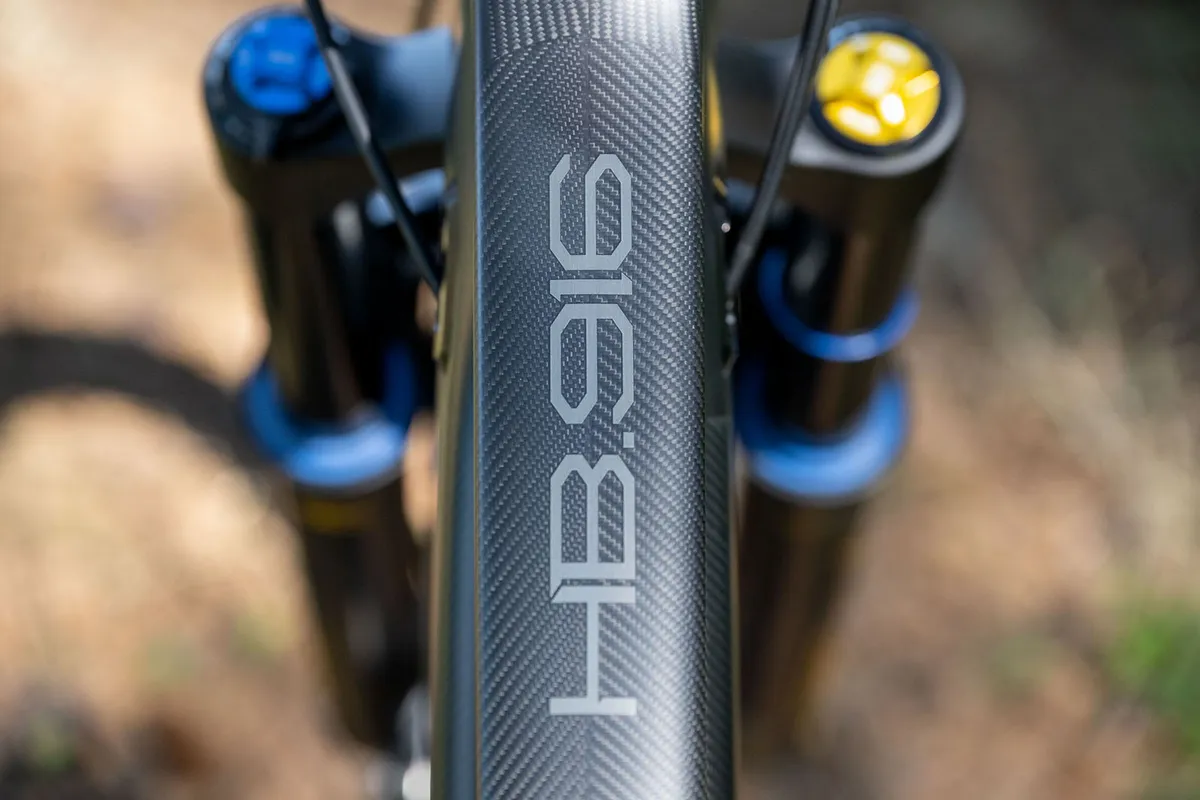
Just as Hope did with the HB.160, the HB.916 is manufactured in its UK facility, using pre-preg carbon sheets laid into intricately CNC-machined moulds to create the front triangle.
At the rear, just as you’d expect from Hope, there’s a smattering of machined aluminium. In this instance, Hope used an aluminium rocker, along with pivot locations and bridges that are bonded to carbon seat and chainstays.
But that’s where the similarities with the older HB.160 end. The suspension layout is now entirely different. There’s a high-pivot (well, semi-high or ‘mid’ pivot, similar to that of the Cannondale Jekyll) used to generate a more rearward, bump-swallowing axle path while delivering the 160mm of travel.
In line with the main pivot is an idler wheel, though this sits back a little from the pivot position and is fixed to the chainstay. Its job is to help mitigate pedal kickback – a trait common with high-pivot suspension designs. A small guide wraps the upper part of the idler to help prevent the chain from skipping off.
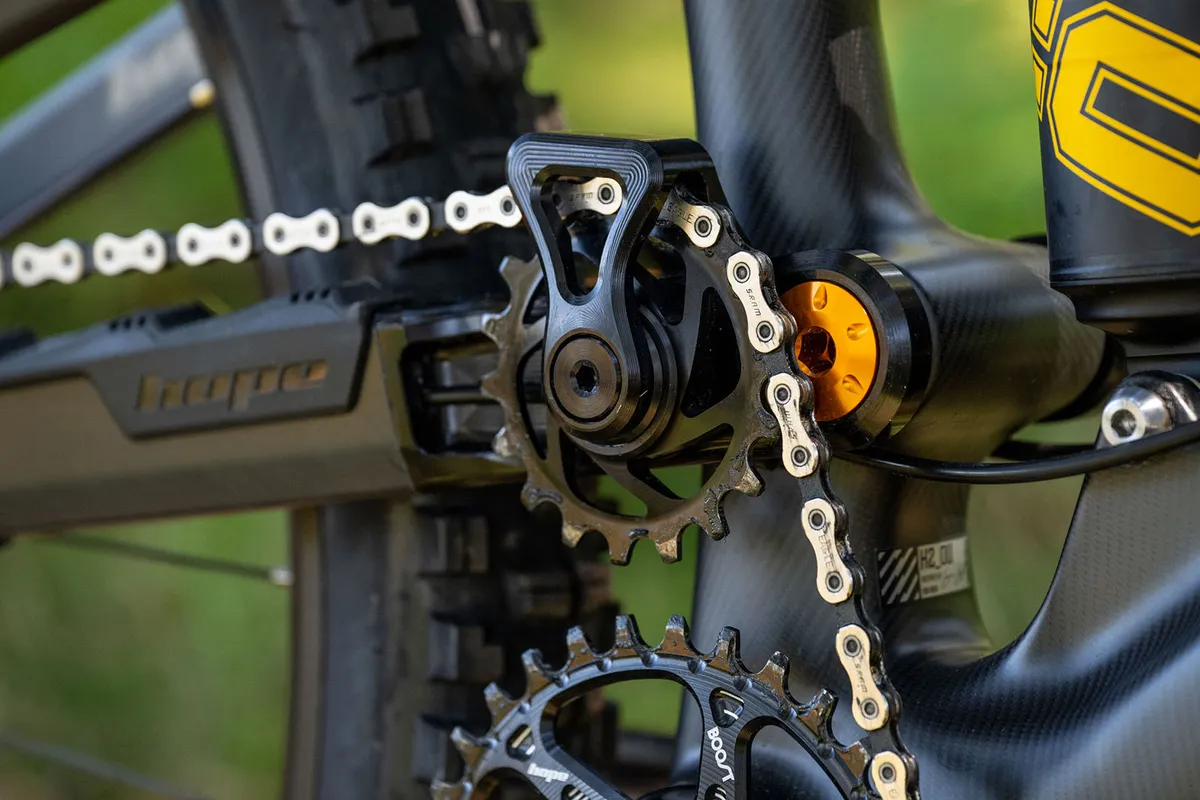
You’ll also spot that there’s no Horst-link pivot either. Instead, the pivot that was located on the chainstay now sits concentric to the rear axle, similar to that seen on bikes from Trek and Pivot. This should, in theory, help reduce the amount the bike squats under braking.
Unlike the narrower 130x17mm axle spacing found on the HB.160, the HB.916 boasts the far more common 148x12mm standard, which should make swapping wheels in and out far easier for most consumers. You’ll also be able to fit 2.6in tyres if you so wish.
There’s room inside the front triangle for a water bottle and, in a similar fashion to Specialized, Trek and Santa Cruz, there’s a compartment within the down tube – dubbed the ‘Butty Box’ by Hope – to stow essentials.
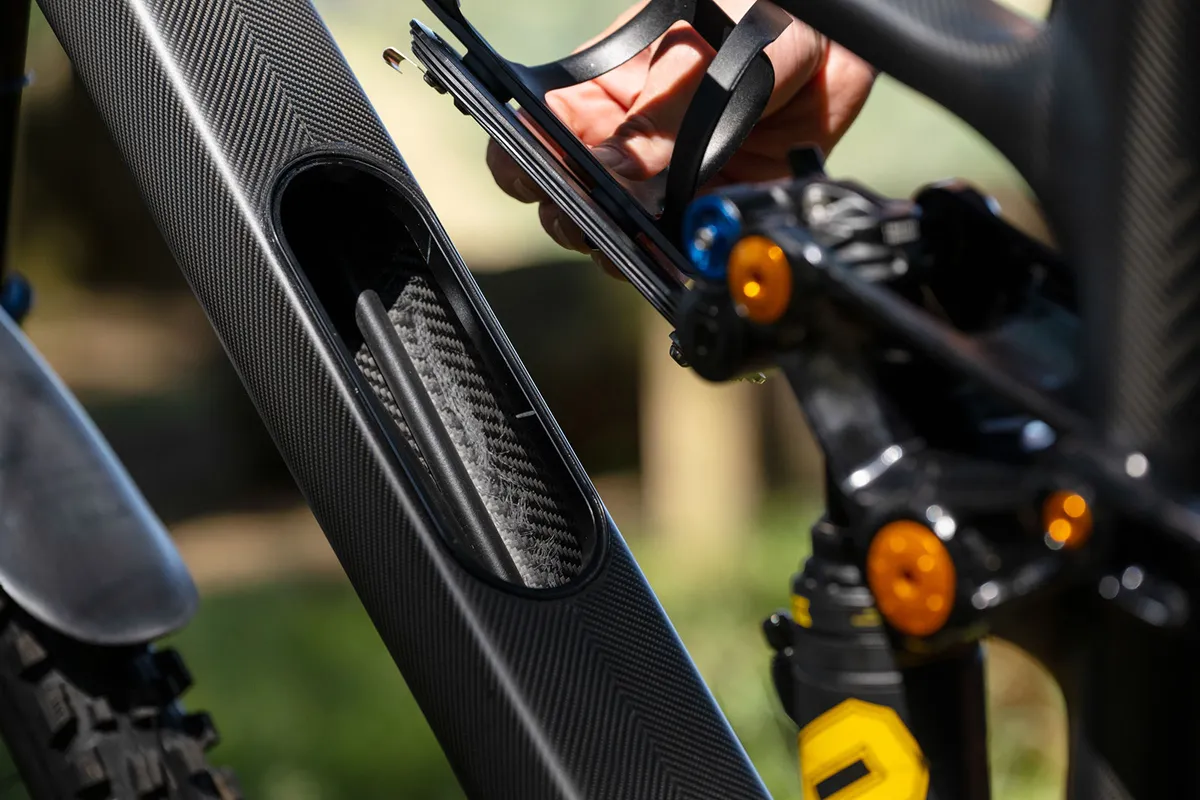
Hope supplies a pouch for you to pack with spares, though my test bike didn’t come with one.
If you’re keen to pimp your ride, Hope offers the HB.916 with six different anodised colours for all pivot hardware, which you can then match with your Hope component choices.
Inside the down tube, you’ll spy the foam sleeves that cover the cables to help prevent any annoying cable rattle while riding.
Hope HB.916 geometry
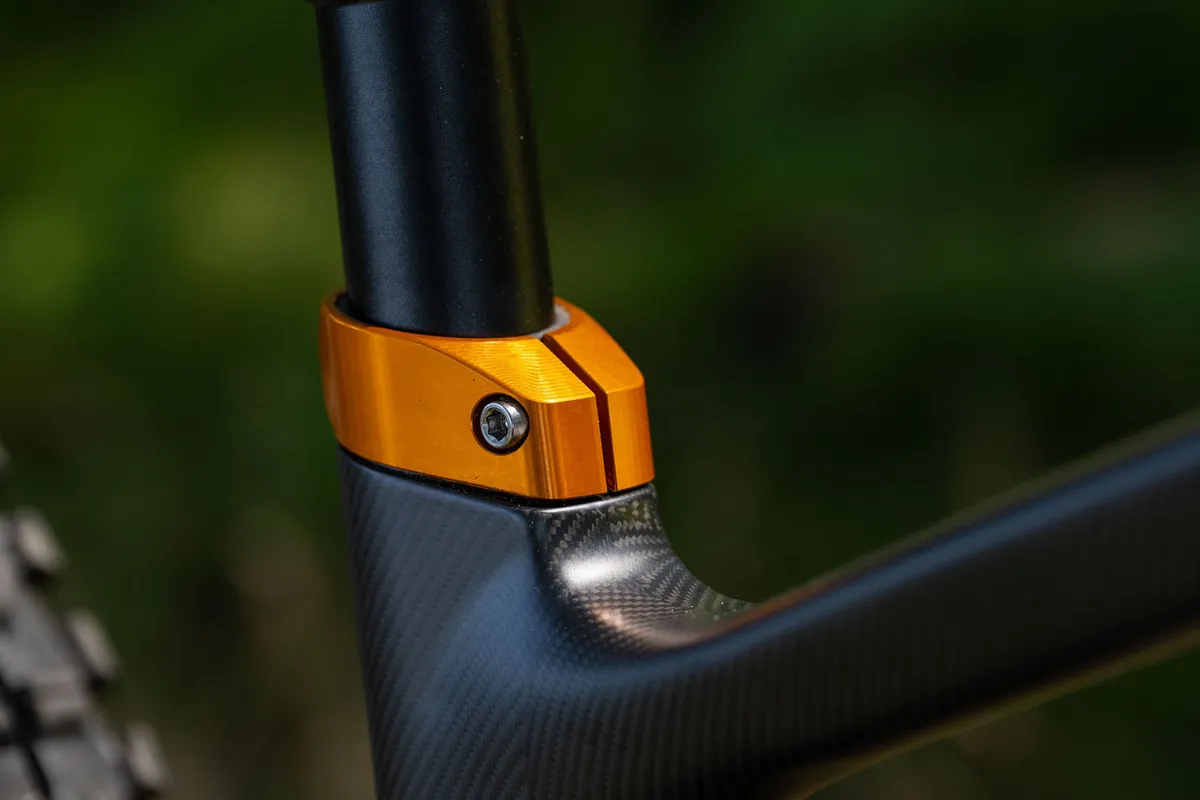
Hope offers the HB.916 in four different sizes (H1, H2, H3 and H4). With relatively short seat tubes and long dropper posts available, choosing a size is based not just on rider size, but handling characteristics, too, a little like Specialized’s ‘S’ and Cotic’s ‘C’ frame sizing.
At 172cm, I was more than comfortable on the H2 frame, which has a 410mm seat tube and reach of 467mm (using a 180mm-travel OneUp Components dropper). I could also have fitted onto the H3 frame, which sports a 440mm seat tube and longer 487mm reach. Equally, I’d have been at home on the H1 frame (447mm reach) with the 210mm-travel OneUp Components dropper post.
A flip chip at the seatstay pivot enables you to switch between high and low settings (altering the head angle by around one degree) and fit a smaller 27.5in rear wheel if you prefer – something I tried during testing.
In the low setting, with the mixed wheel-size setup, I measured the HB.916 head angle to be a slack 63 degrees. The seat tube angle was steep at 79 degrees with the saddle set to my preferred position.
Hope has chosen to keep the chainstay measurement identical across all frame sizes at 440mm. It’s worth noting that the chainstay length will grow as the back end of the bike is compressed.
This figure isn’t crazy, though, growing by just over 9mm when the bike is in and around the halfway point through its travel before continuing to arc up and forwards until full travel is reached.
Thanks in part to that lengthy reach and slack head angle, the front centre of the H2 test bike measured 835mm – numbers you’d likely find on a downhill bike.
I measured the bottom bracket to sit 335mm off of the floor, which is relatively low considering the travel on tap.
| | H1 | H2 | H3 | H4 |
|---|---|---|---|---|
| Seat angle (degrees) | 78 / 78.2 | 77.9 / 78.1 | 77.7 / 77.9 | 77.5 / 77.7 |
| Head angle (degrees) | 64 / 63.2 | 64 / 63.2 | 64 / 63.2 | 64 / 63.2 |
| Chainstay (mm) | 440 | 440 | 440 | 440 |
| Seat tube (mm) | 395 | 410 | 440 | 470 |
| Top tube (mm) | 583.5 / 580.5 | 606.5 / 603.5 | 631 / 628 | 655 / 652 |
| Head tube (mm) | 100 | 110 | 120 | 130 |
| Fork offset (mm) | 44 | 44 | 44 | 44 |
| Bottom bracket drop (mm) | 30 / 31.5 | 30 / 31.5 | 30 / 31.5 | 30 / 31.5 |
| Bottom bracket height (mm) | 344 / 342.5 | 344 / 342.5 | 344 / 342.5 | 344 / 342.5 |
| Wheelbase (mm) | 1,230 / 1,238 | 1,254 / 1,262 | 1,278.5 / 1,286.5 | 1,303 / 1,311 |
| Standover (mm) | 700 | 710 | 725 | 740 |
| Stack (mm) | 628 / 627 | 637 / 636 | 646 / 645 | 655 / 654 |
| Reach (mm) | 450 / 447 | 470 / 467 | 490 / 487 | 510 / 507 |
Hope HB.916 specification
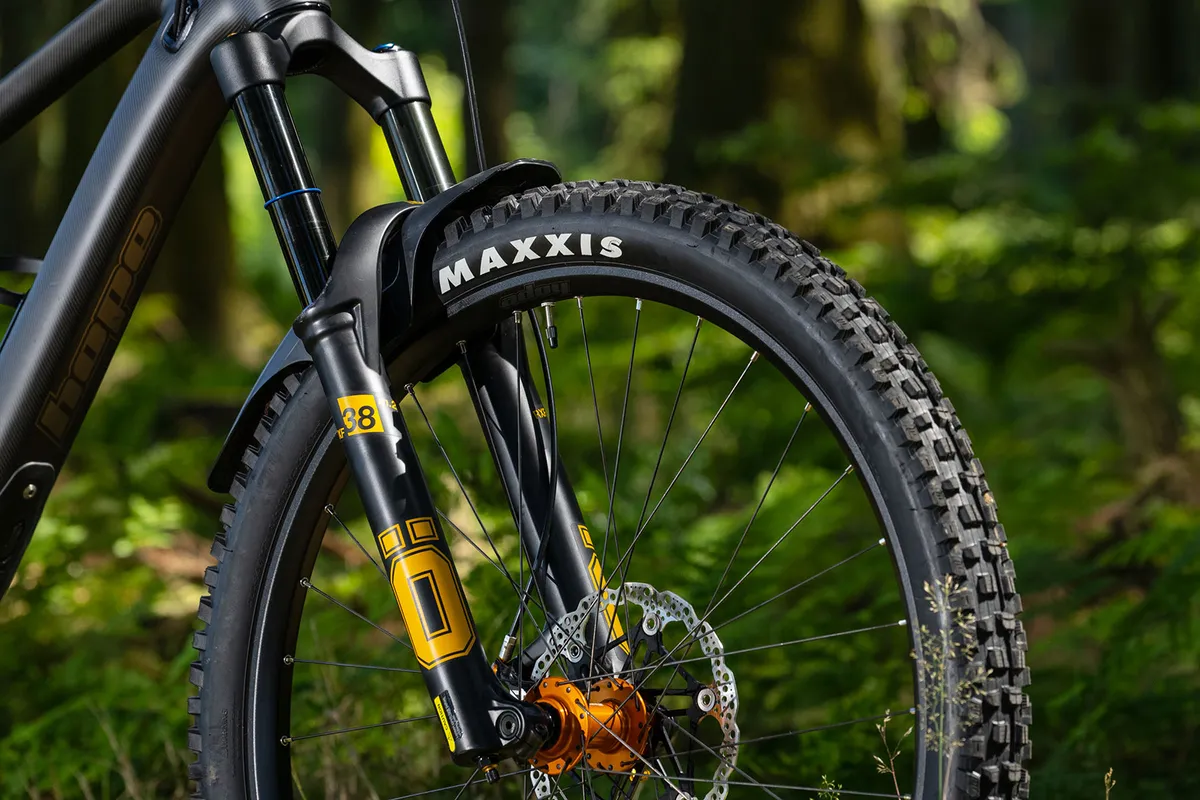
Hope offers the HB.916 as a frameset, complete (excluding the drivetrain) or as a fully built bike, as seen here.
As you’d expect, Hope provides a good chunk of the componentry (the brand doesn’t make dropper posts, full drivetrains or tyres, but does make nearly everything else), including wheels, carbon bars, cranks, headset, stem and brakes.
The brakes in question are Hope's new Tech 4 V4 numbers, paired with the brand’s Floating rotors. These feature both bite-point and reach adjustment (which can be done by hand, without the need for any tools).
My test bike wasn’t quite the same as listed on the Hope website, featuring SRAM’s GX Eagle gearing rather than the X01 Eagle stated online.
Wrapping the Hope Fortus 30SC rims are Maxxis tyres. Up-front sits an Assegai 3C MaxxTerra EXO, while at the rear there’s a Minion DHR II 3C MaxxTerra EXO+ (though the 27.5in tyre supplied used a lighter EXO casing).
Aside from the Hope parts, the biggest talking points have to be the fork and shock, both of which come from Öhlins.
Up-front, the RXF38 m.2 fork uses the TTX18 damper to control the 170mm of travel, while the TTX2 Air looks after everything at the rear.
The complete weight of the H2-size HB.916 I had on test with the smaller 27.5in wheel and lighter EXO casing fitted was 15.32kg (without pedals).
Hope HB.916 ride impressions
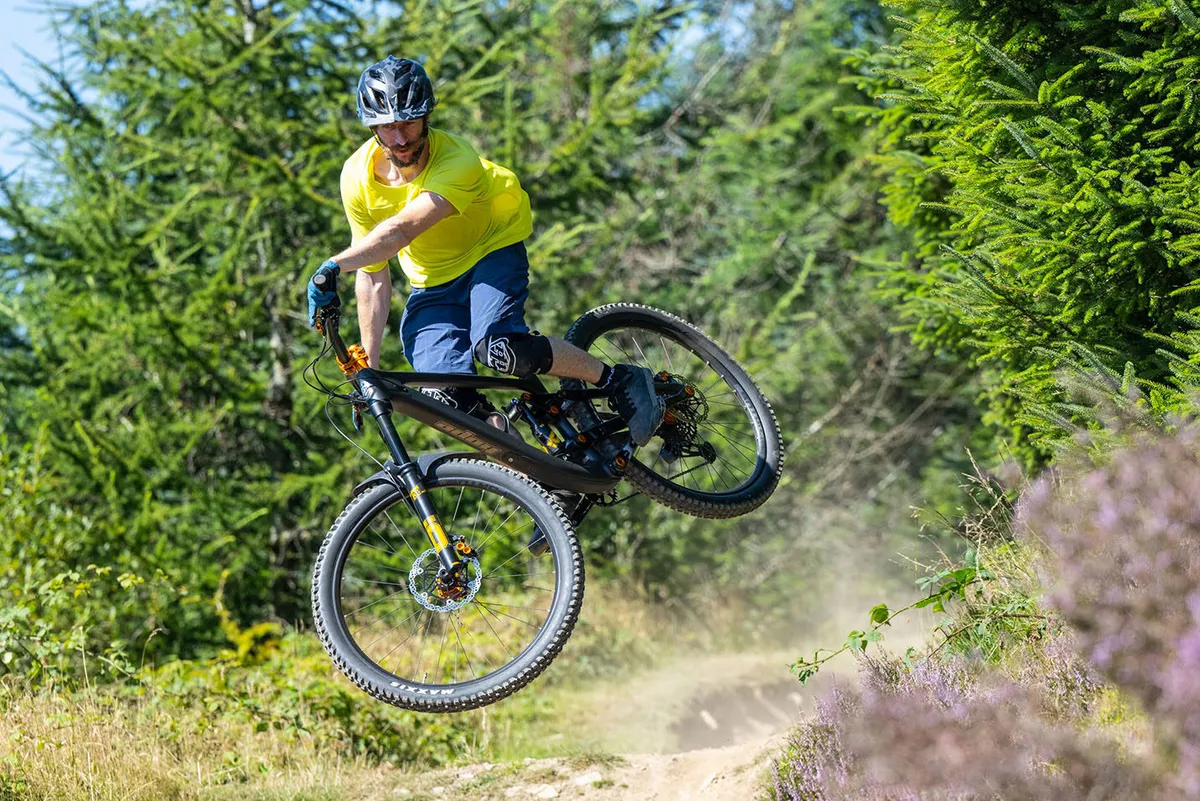
To test the HB.916, I rode it on a variety of trails in diverse conditions. These included steep, tight, technical and rocky tracks through to higher-paced rough, root-riddled natural tracks that really put the bike through its paces.
As ever, I rode the Hope HB.916 back-to-back with other similarly intended enduro bikes in a bid to get a measure of how it performs compared to some of the best out there.
Hope HB.916 setup
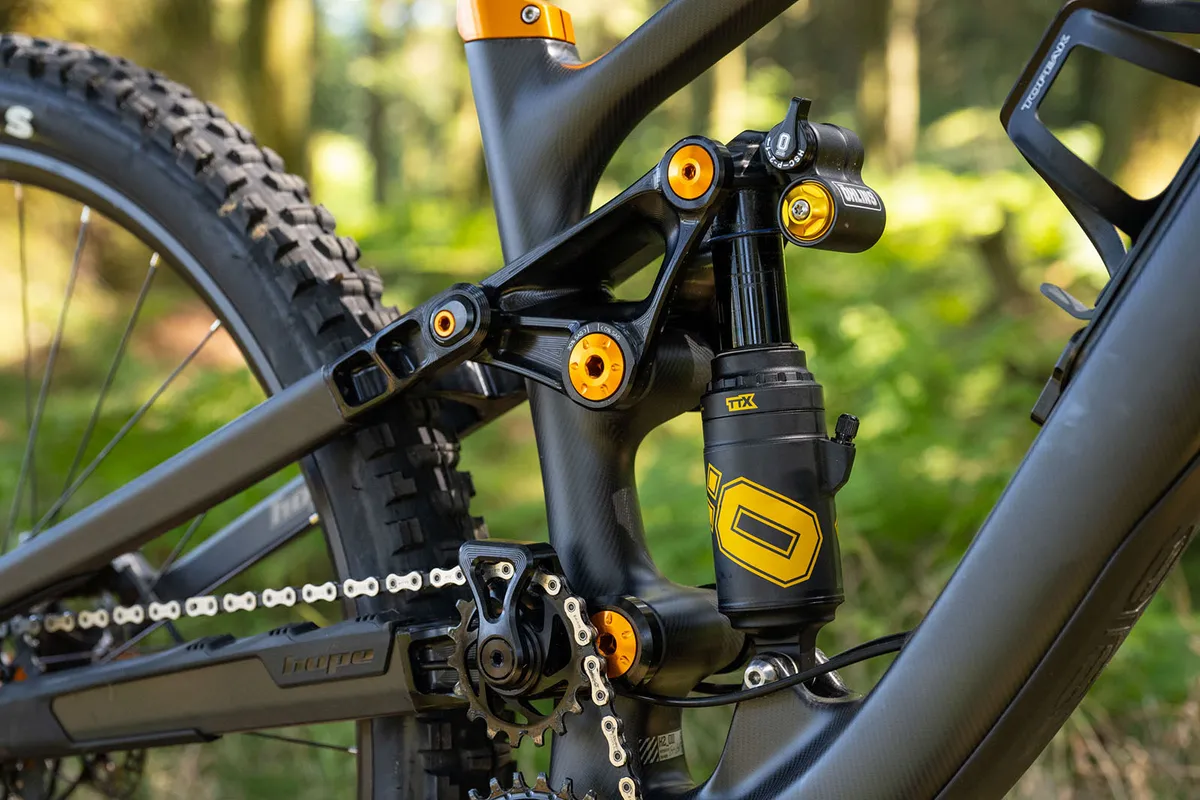
Setting up the Öhlins suspension required quite a bit of trial and error to get the HB.916 feeling as I wanted.
This was maybe down in part to the fact that I’m not as familiar with the brand's forks and shocks as I am with others. However, I also felt the damping could have been a little lighter for my weight (68kg).
In the end, after much experimentation, I ended up with 71psi in the main chamber of the fork, with 161psi in the ramp-up chamber and 10 clicks of low-speed compression damping (counted from fully closed), while leaving the high-speed compression adjuster fully open throughout. I ran 14 clicks of rebound damping.
At the rear, I set the sag at 30 per cent, which equated to 148psi, but opened up all the damping adjusters fully.
Öhlins does offer some handy setup guides on its website, though at the time of writing, the HB.916 wasn’t included. However, it also offers its ‘settings bank’ service, which enables you to work with your local Öhlins service centre, who’ll be able to advise on not just settings, but damper shim arrangements, too, depending on your weight and riding style.
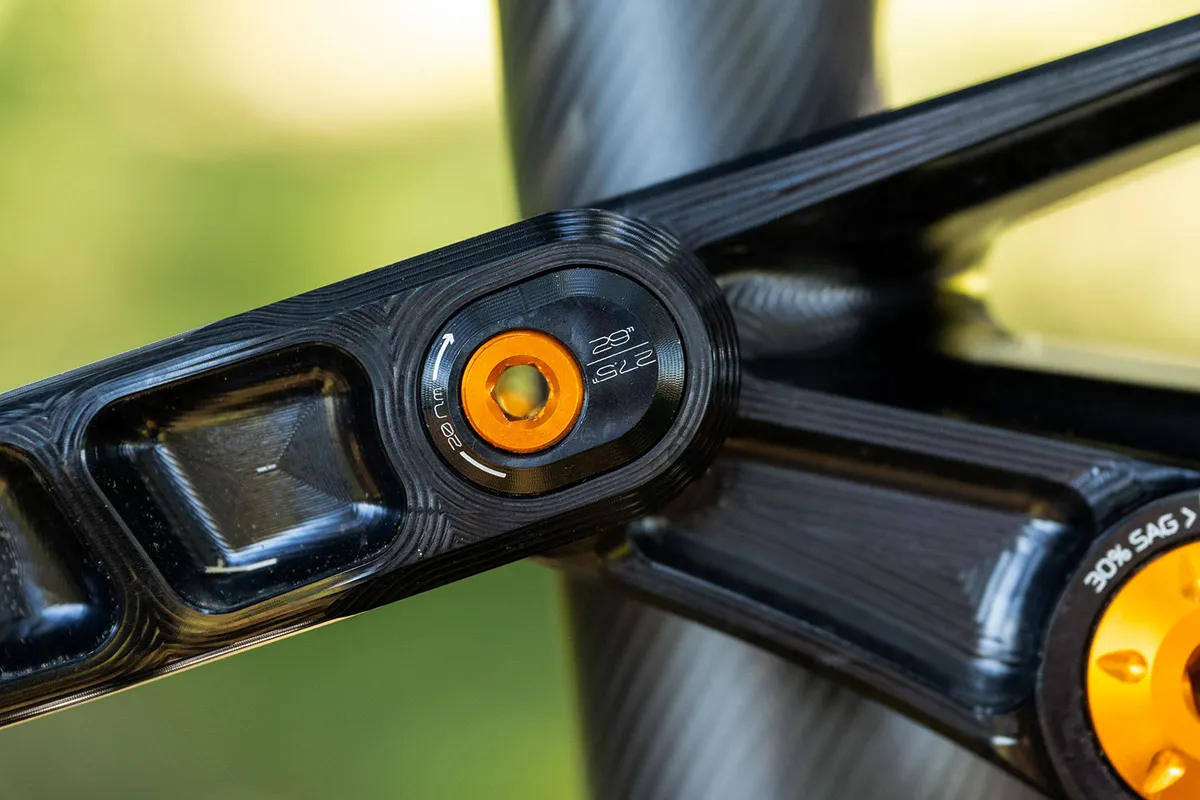
Although I started with both 29in wheels in place, I switched to the smaller 27.5in rear wheel part way through testing.
Before heading out, I wanted to stash some essentials in the frame’s ‘Butty Box’, located within the down tube. Unfortunately, as I mentioned earlier, Hope didn’t supply the pouch to stow kit securely and rattle-free.
Accessing the opening itself is a little more industrial than I’ve experienced with other bikes that offer a similar storage feature.
It’ll work but requires a little more dexterity and effort to open the hatch up. Still, I consider it a plus to have it included.
Hope HB.916 climbing performance

With the HB.916 pointed uphill, that steep seat tube angle is noticeable instantly, perching you right up over the bottom bracket when seated and winching up the climbs.
The long front centre and slack head angle stick the front wheel a good distance out in front of you and at no point, even on really steep inclines, did I struggle with the front wheel lifting.
At the rear, the back end of the bike remains very calm under power. There’s a little movement through the rear suspension when sat down and pedalling, with the shock sitting high in its stroke and resisting the need to squat down with every turn of the cranks.
This makes things feel incredibly stable when working hard, highlighting just how much pep the HB.916 has when climbing – it certainly feels more eager than other high-pivot designs I’ve ridden.
There’s a little more noise from the drivetrain when using the two easiest gears, compared to a bike with a lower main pivot and no idler wheel, but this didn’t feel as though it translated into drag or impacted forward progress at all – something that can occur on bikes with higher main pivots that use an idler.
While the rear end remains calm under power, it’s free enough to allow the shock to work away, keeping the rear tyre stuck to the floor as you inch your way up steeper pitches.Time and time again, I was surprised by just how capable the HB.916 was when climbing, and what I was able to comfortably claw my way up.
It might not be the lightest bike, and the suspension design adds an idler wheel into the mix, but I never felt it held me back on the climbs.
Hope HB.916 descending performance
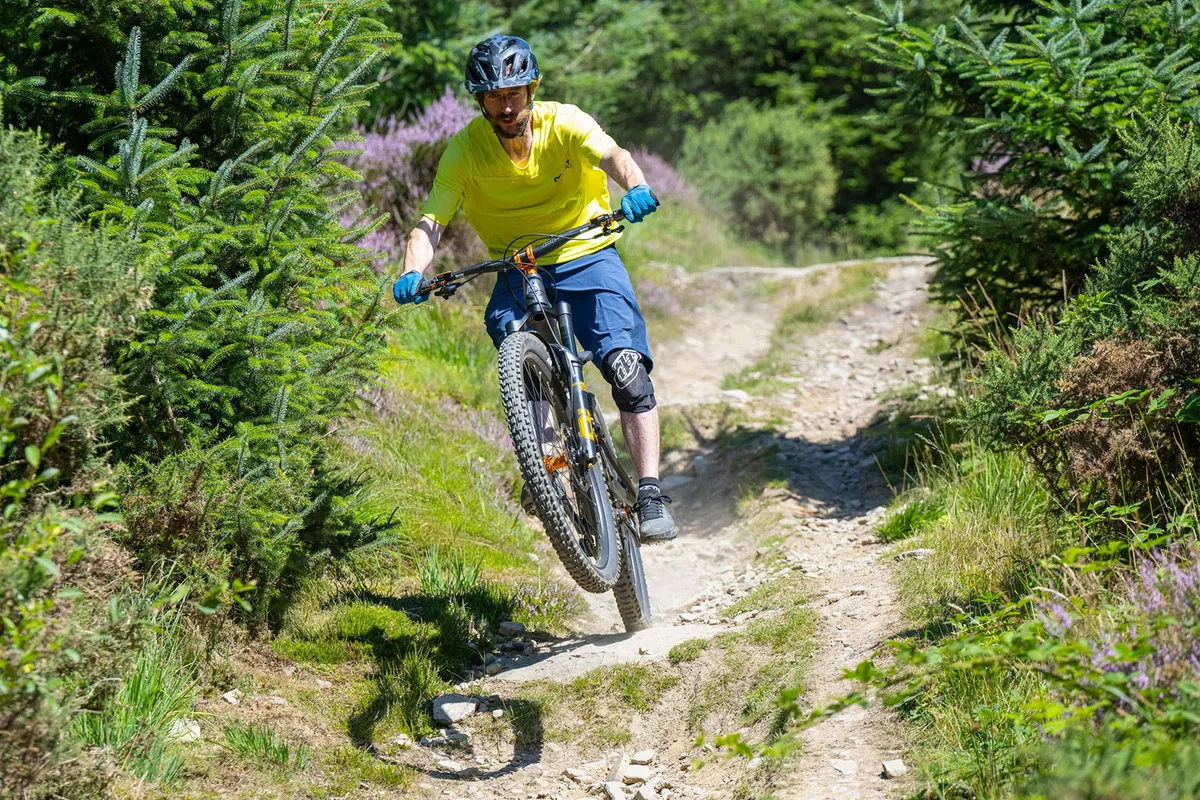
The HB.916 is a formidable beast when aimed down the trail. However, I needed to take some time fiddling with the fork and shock to get the most out of the bike.
The Öhlins suspension had me trying different settings for the first couple of days of testing in a bid to narrow down an ideal ride feel for me.
After following the pressure chart on the side of the fork, my initial impression was although the bike felt quite dynamic and lively, it wasn’t as comfortable or as forgiving as I’d have hoped.
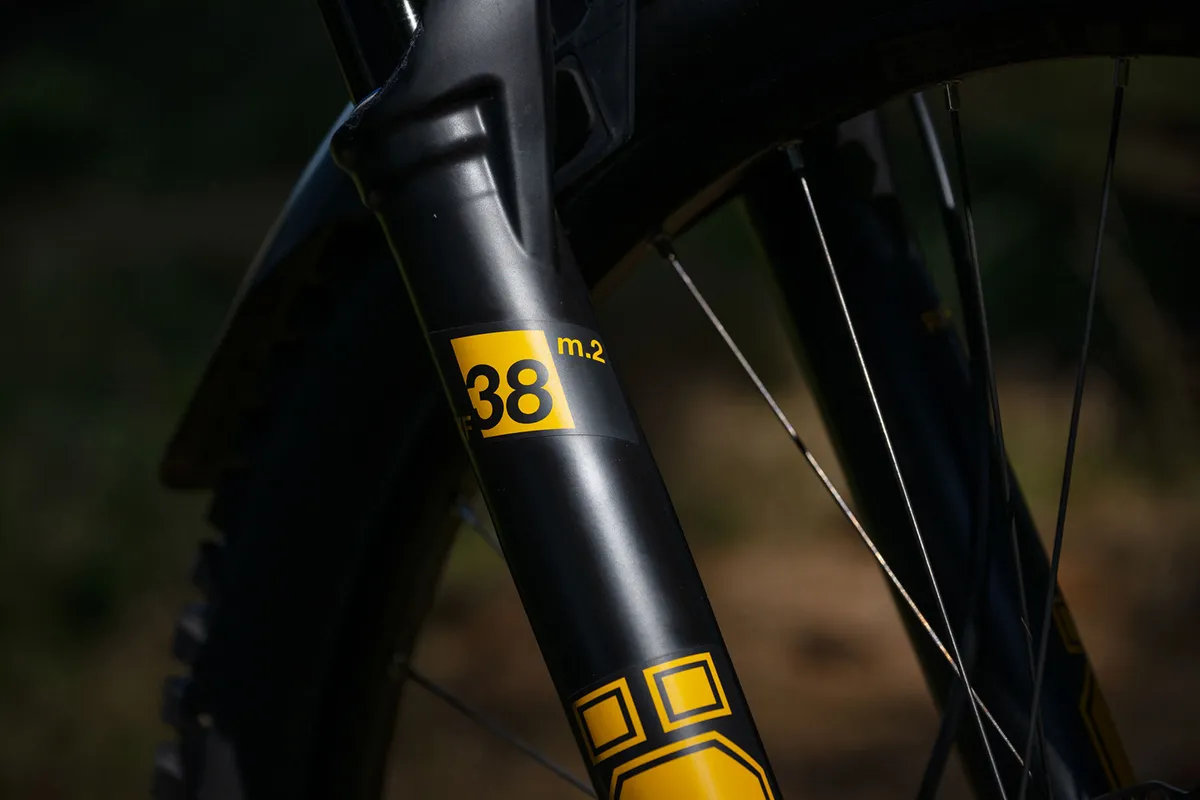
I then dropped pressure significantly in both the fork and shock, which boosted traction and comfort massively, but left the bike glued to the trail. In the end, the fork pressures I settled on were roughly 10psi lower than recommended, but this gave me a great mix of feel through the wheels and enough compliance to soak up smaller hits and chatter.
That said, despite running some low-speed compression damping on the fork (to help keep the front end propped up while running a slightly lower pressure in the main chamber) and a little rebound, too, I left the shock’s adjusters fully open to get the feel I was after. Lighter riders may struggle to find their preferred setup.
Given more time with the bike, I’d have visited an Öhlins service centre and looked to alter the fork and shock tune to best suit my weight and riding style.
The only other thing worth commenting on regarding the ride feel is just how stiff the Hope carbon handlebar feels when tackling high-speed, high-frequency bumps. Swapping to a more forgiving handlebar is an easy fix, though.
All change
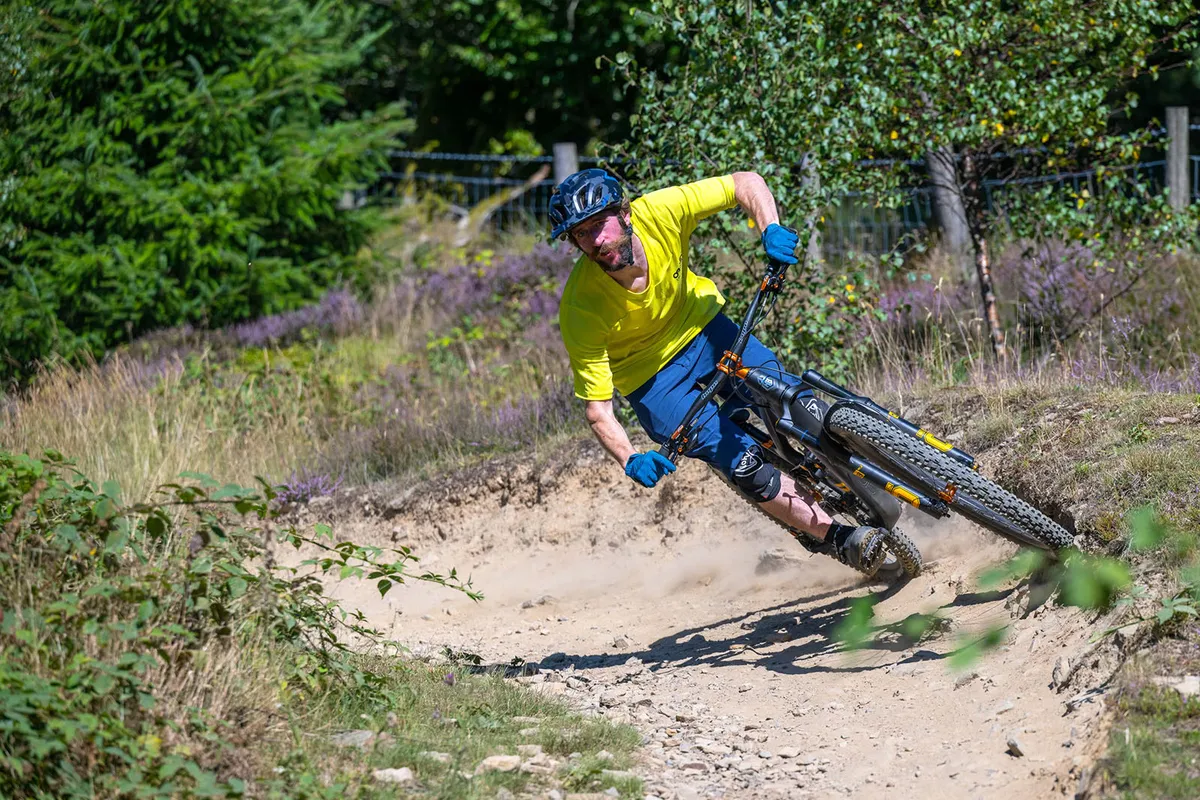
While I felt comfortable enough with the bigger wheels in place, set as a full 29er, the HB.916 felt like a big bike, and on steeper terrain or dealing with massive compressions, I frequently felt my backside getting buzzed by the rear wheel – not something I experience on every 29er I ride.
Why I experienced this more on the Hope than many other bikes is a tricky one to pin down. It could be due to the short seat tube and 180mm-travel dropper post.
With the saddle dropped completely, I had masses of saddle-to-backside clearance, meaning I could get lower on the HB.916 than I'd expect on many other bikes. That also meant my bottom could get closer to the rear wheel more easily.
After a couple of days of testing with a 29in wheel in the front and rear, I switched over to a smaller 27.5in at the rear.
Swapping to the smaller wheel took no time at all and instantly solved any clearance issues at the rear… with my rear.
From that point on, I really became more comfortable on the HB.916 and felt I could attack the trail with more aggression, dropping the bike into tight turns with less input and effort, as well as feeling as though I had more space to move around on the bike.
High-pivot hero
With the smaller wheel in place and the suspension set up just how I liked it, my confidence grew quickly when riding ever more challenging descents at pace.
There’s nothing that gets the heart going quite like tanking into a matted root spread that’s just had a fresh coating of rain. In these situations, I was especially impressed by just how calm and surefooted the HB.916 was.
While the stretched-out front centre and slack head angle help to contribute to the stability here, the suspension certainly plays its part, too.
The HB.916 does a great job of smoothing jagged edges and keeping the rear wheel in contact with the ground as much as it possibly can. The calmness this creates helps you ride technical lines more easily or a touch faster with a little more confidence.
But while it scalps those bumps impressively well, there’s still plenty of feedback – albeit sufficiently softened and comfortable feedback - coming up through the wheels, which helps ensure there’s still a nice, reactive, responsive feel to the bike when you need it.
This makes you want to push that bit harder and really let go of the brakes when navigating steep, technical turns – a place that the HB.916 really shines thanks to the balance and traction on tap.
In really rowdy terrain, the action of the supple suspension and well-damped frame feel produce a muted feel through the bike, but without losing that connection to the trail.
Braking the mould
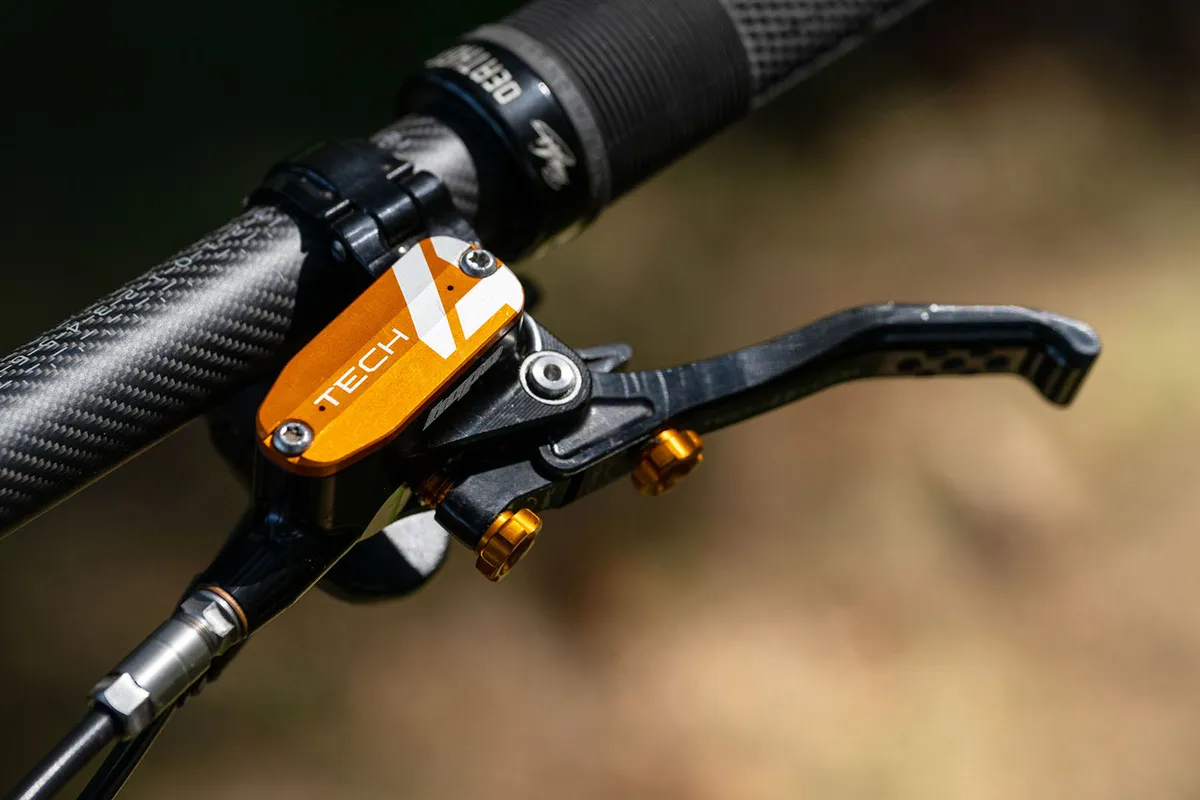
I’ll admit, while I can thoroughly appreciate the workmanship, quality and level of support offered when you buy Hope brakes, I’ve not been sold on the power and feel through the lever for some time now.
The new Tech 4 V4 brakes feel like a massive improvement, though. There’s far more predictable punch when you need it most, and on steeper, longer descents, my hands stayed feeling fresh and strong – something I think a lot of testers didn’t feel with the older brakes.
When it comes to the rest of the kit, everything worked as promised, but I’d be keen to switch to a more compliant handlebar if I could.
How does the Hope HB.916 compare to other mid- or high-pivot enduro bikes?
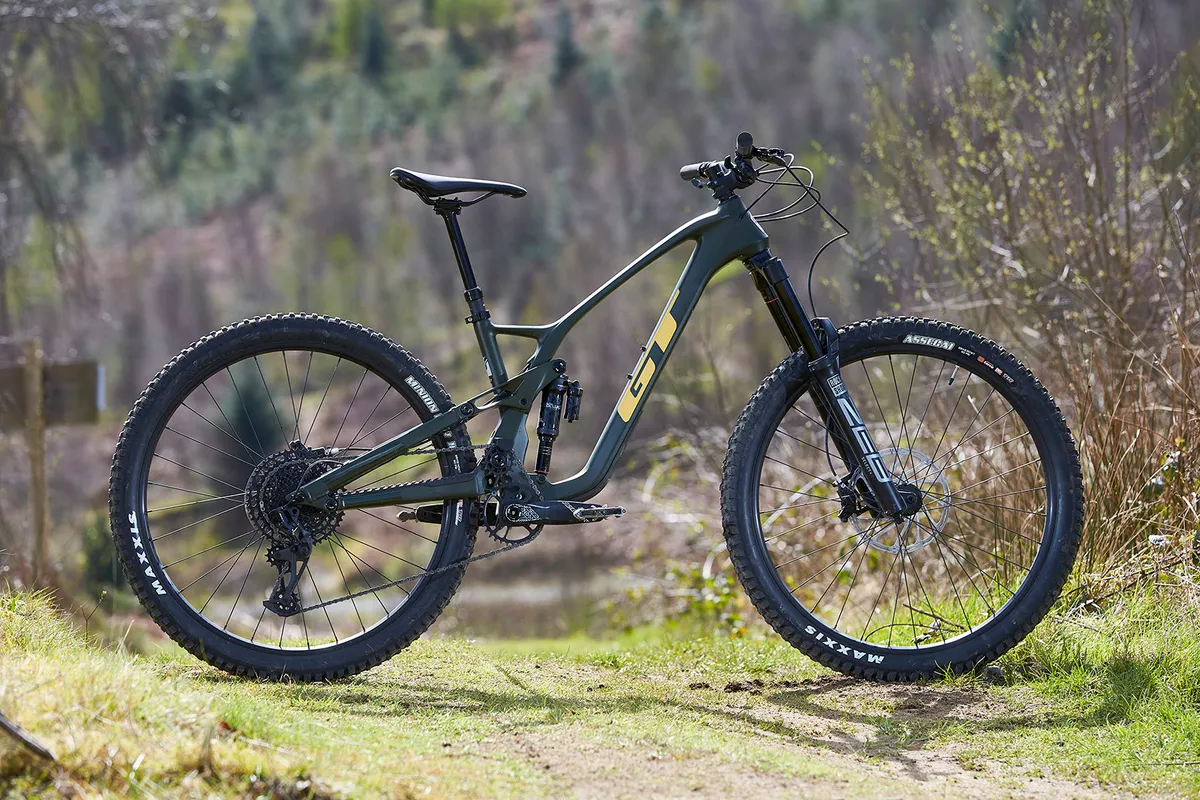
Over the last year or so, I’ve ridden a few ‘mid pivot’ bikes that are worth comparing the HB.916 to.
The GT Force Carbon Pro doesn’t climb as well or as eagerly as the Hope, but going downhill, the Force doesn’t just take the edges off square-edge hits, it properly swallows them. This leaves it feeling a little less agile and more like a drop-your-heels-and-plough-through-the-chunder type of bike.
Then there’s the Cannondale Jekyll 2, which pedals better than the GT but still not quite as well as the Hope. The Jekyll offers more feedback than the GT, though, and doesn’t smooth the trail in the same way.
Hope’s HB.916 feels in many ways as though it sits somewhere in the middle of the two. While its muted, well-damped ride feel boosts confidence when going fast in the rough, there’s still a liveliness to proceedings that ensures you can pick it up and place it exactly where you need it to go.
Hope HB.916 bottom line
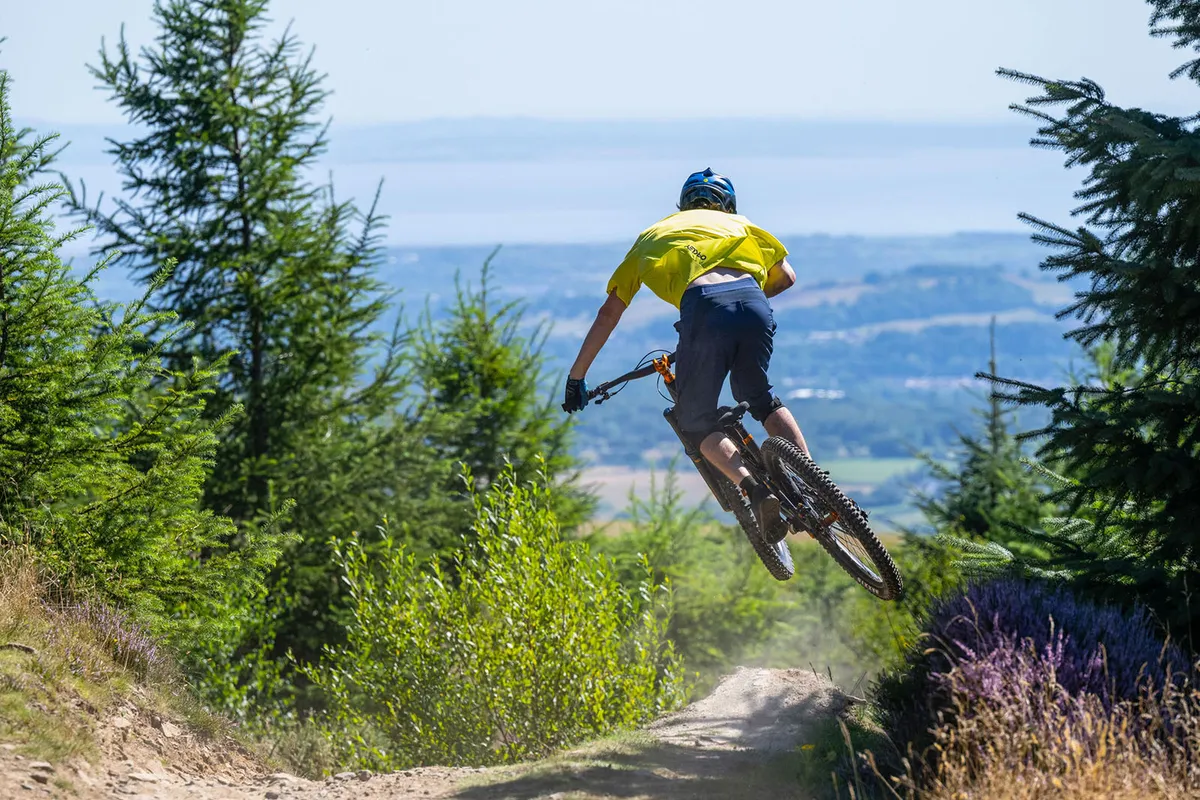
The HB.916 may be from the same brand, but it’s an entirely different beast from the HB.160 it replaces.
Thanks to impressive geometry and well-balanced suspension feel, Hope has done a great job of creating a bike happy to be plunged into the most technical terrain, but without dulling any of the fun and excitement while doing so.
Sure, it’s very capable, but it’s loads of fun to ride, too.
Careful suspension setup does take time, but the rewards are there if you put in the effort.
Product
| Brand | hope |
| Price | 6995.00 GBP |
| Weight | 15.3200, GRAM (H2) - without pedals |
Features
| Fork | Ohlins RXF38 m2, 170mm travel |
| br_stem | Hope AM, 35mm |
| br_chain | SRAM GX Eagle |
| br_frame | Carbon front triangle, carbon/alu rear end, 160mm travel |
| Tyres | Maxxis Assegai 3C MaxxTerra EXO 29x2.5in (fr), Maxxis Minion DHR II 3C MaxxTerra EXO+ 29x2.4in (r) |
| br_brakes | Hope Tech4 V4 (200mm/180mm rotors) |
| br_cranks | Hope Evo |
| br_saddle | WTB Volt |
| br_wheels | Hope Fortus 30SC rims on Hope Pro4 hubs |
| br_shifter | SRAM GX Eagle |
| br_cassette | SRAM GX Eagle |
| br_seatpost | OneUp Components Dropper V2, 210mm |
| br_gripsTape | DMR Deathgrips |
| br_handlebar | Hope Carbon, 800mm |
| br_rearShock | Ohlins TTX2 Air |
| br_availableSizes | H1, H2, H3, H4 |
| br_rearDerailleur | SRAM GX Eagle |
